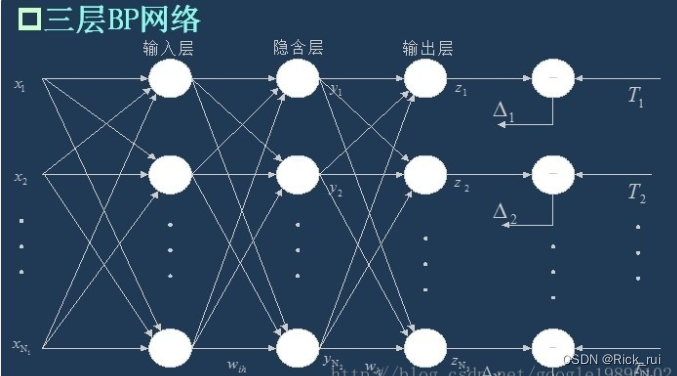一、BP神经网络的概念
BP神经网络是一种多层的前馈神经网络,其主要的特点是:信号是前向传播的,而误差是反向传播的。具体来说,对于如下的只含一个隐层的神经网络模型:

(三层BP神经网络模型)
BP神经网络的过程主要分为两个阶段,第一阶段是信号的前向传播,从输入层经过隐含层,最后到达输出层;第二阶段是误差的反向传播,从输出层到隐含层,最后到输入层,依次调节隐含层到输出层的权重和偏置,输入层到隐含层的权重和偏置。
二、BP神经网络的流程
在知道了BP神经网络的特点后,我们需要依据信号的前向传播和误差的反向传播来构建整个网络。
1、网络的初始化

2、隐含层的输出
如上面的三层BP网络所示,隐含层的输出为:

3、输出层的输出

4、误差的计算 
5、权值的更新
权值的更新公式为:

这里需要解释一下公式的由来:
这是误差反向传播的过程,我们的目标是使得误差函数达到最小值,即
隐含层到输出层的权重更新

则权重的更新公式为:

- 输入层到隐含层的权重更新

其中


则权重的更新公式为:

6、偏置的更新
偏置的更新公式为:

- 隐含层到输出层的偏置更新

则偏置的更新公式为:

- 输入层到隐含层的偏置更新

其中


则偏置的更新公式为:

7、判断算法迭代是否结束
有很多的方法可以判断算法是否已经收敛,常见的有指定迭代的代数,判断相邻的两次误差之间的差别是否小于指定的值等等。
**代码 **
package machinelearning.ann;
import java.io.FileReader;
import java.util.Arrays;
import java.util.Random;
import weka.core.Instances;
/**
* General ANN. Two methods are abstract: forward and backPropagation.
*
* @author Rui Chen [email protected].
*/
public abstract class GeneralAnn {
/**
* The whole dataset.
*/
Instances dataset;
/**
* Number of layers. It is counted according to nodes instead of edges.
*/
int numLayers;
/**
* The number of nodes for each layer, e.g., [3, 4, 6, 2] means that there
* are 3 input nodes (conditional attributes), 2 hidden layers with 4 and 6
* nodes, respectively, and 2 class values (binary classification).
*/
int[] layerNumNodes;
/**
* Momentum coefficient.
*/
public double mobp;
/**
* Learning rate.
*/
public double learningRate;
/**
* For random number generation.
*/
Random random = new Random();
/**
********************
* The first constructor.
*
* @param paraFilename
* The arff filename.
* @param paraLayerNumNodes
* The number of nodes for each layer (may be different).
* @param paraLearningRate
* Learning rate.
* @param paraMobp
* Momentum coefficient.
********************
*/
public GeneralAnn(String paraFilename, int[] paraLayerNumNodes, double paraLearningRate,
double paraMobp) {
// Step 1. Read data.
try {
FileReader tempReader = new FileReader(paraFilename);
dataset = new Instances(tempReader);
// The last attribute is the decision class.
dataset.setClassIndex(dataset.numAttributes() - 1);
tempReader.close();
} catch (Exception ee) {
System.out.println("Error occurred while trying to read \'" + paraFilename
+ "\' in GeneralAnn constructor.\r\n" + ee);
System.exit(0);
} // Of try
// Step 2. Accept parameters.
layerNumNodes = paraLayerNumNodes;
numLayers = layerNumNodes.length;
// Adjust if necessary.
layerNumNodes[0] = dataset.numAttributes() - 1;
layerNumNodes[numLayers - 1] = dataset.numClasses();
learningRate = paraLearningRate;
mobp = paraMobp;
}//Of the first constructor
/**
********************
* Forward prediction.
*
* @param paraInput
* The input data of one instance.
* @return The data at the output end.
********************
*/
public abstract double[] forward(double[] paraInput);
/**
********************
* Back propagation.
*
* @param paraTarget
* For 3-class data, it is [0, 0, 1], [0, 1, 0] or [1, 0, 0].
*
********************
*/
public abstract void backPropagation(double[] paraTarget);
/**
********************
* Train using the dataset.
********************
*/
public void train() {
double[] tempInput = new double[dataset.numAttributes() - 1];
double[] tempTarget = new double[dataset.numClasses()];
for (int i = 0; i < dataset.numInstances(); i++) {
// Fill the data.
for (int j = 0; j < tempInput.length; j++) {
tempInput[j] = dataset.instance(i).value(j);
} // Of for j
// Fill the class label.
Arrays.fill(tempTarget, 0);
tempTarget[(int) dataset.instance(i).classValue()] = 1;
// Train with this instance.
forward(tempInput);
backPropagation(tempTarget);
} // Of for i
}// Of train
/**
********************
* Get the index corresponding to the max value of the array.
*
* @return the index.
********************
*/
public static int argmax(double[] paraArray) {
int resultIndex = -1;
double tempMax = -1e10;
for (int i = 0; i < paraArray.length; i++) {
if (tempMax < paraArray[i]) {
tempMax = paraArray[i];
resultIndex = i;
} // Of if
} // Of for i
return resultIndex;
}// Of argmax
/**
********************
* Test using the dataset.
*
* @return The precision.
********************
*/
public double test() {
double[] tempInput = new double[dataset.numAttributes() - 1];
double tempNumCorrect = 0;
double[] tempPrediction;
int tempPredictedClass = -1;
for (int i = 0; i < dataset.numInstances(); i++) {
// Fill the data.
for (int j = 0; j < tempInput.length; j++) {
tempInput[j] = dataset.instance(i).value(j);
} // Of for j
// Train with this instance.
tempPrediction = forward(tempInput);
//System.out.println("prediction: " + Arrays.toString(tempPrediction));
tempPredictedClass = argmax(tempPrediction);
if (tempPredictedClass == (int) dataset.instance(i).classValue()) {
tempNumCorrect++;
} // Of if
} // Of for i
System.out.println("Correct: " + tempNumCorrect + " out of " + dataset.numInstances());
return tempNumCorrect / dataset.numInstances();
}// Of test
}//Of class GeneralAnn
版权归原作者 Rick_rui 所有, 如有侵权,请联系我们删除。